 |
 |
 |
| |
Clinical Presentation of Hypersensitivity Reaction to Abacavir (ABC HSR) by HLA-B*5701 Status
|
| |
| |
Reported by Jules Levin, Monday evening Sept 17
ICAAC, Chicago, Sept 17-20,2007
C. Martorell1, M. Saag2, G. Blick3, R. Corales4, P. Brachman5, R. Balu6, B. Stancil6, D. Sutherland-Phillips6, P. Wannamaker6 and C. Brothers6
1ID Res. Inst., Springfield, MA, 2Univ. of Alabama-Birmingham, Birmingham, AL, 3Circle Med., LLC, Norwalk, CT, 4ACHC, Rochester, NY, 5The Atlanta ID Group PC, Atlanta, GA, 6GlaxoSmithKline, Research Triangle Park, NC
AUTHOR DISCUSSION
The current analysis expands upon the original SHAPE analyses by examining differences in clinical presentation by HLA-B*5701 status:
--These differences may be particularly relevant as prospective screening for HLA-B*5701 becomes more widespread
--These data may also help to refine the diagnostic indicators for ABC HSR
--Specific symptoms of fever, malaise, myalgia and fatigue were more commonly reported as ABC HSR in subjects positive for HLA-B*5701 than in those not carrying the allele.
--Time to symptom onset within 21 days of ABC initiation was also more common in subjects positive for HLA-B*5701.
AUTHOR CONCLUSIONS
Subjects carrying the HLA-B*5701 allele were more likely than those without the allele to present with fever and constitutional symptoms, and to have ≥3 categories of ABC HSR symptoms.
Most (94%) of HLA-B*5701+ subjects had onset of ABC HSR symptoms within 21 days of initiating ABC therapy
The median time to onset of symptoms was the same for subjects in both groups (7 days), however HLA-B-5701+ subjects had a narrow range (0-34 days) compared to HLA-B*5701 negative subjects (0-469 days).
HLA-B*5701 was 100% sensitive for SPT+ ABC HSR in this study.
ABSTRACT
OBJECTIVES: ABC HSR typically presents with multiple symptoms, many with overlapping etiologies. The aim of this analysis was to evaluate clinical presentation of ABC HSR by HLA-B*5701 status.
METHODS: Subjects with clinically-suspected ABC HSR (cases) were identified through chart reviews as a part of study ABC107442 (SHAPE). Cases must have had ABC HSR symptoms in ≥ 2 categories (fever, rash, GI, constitutional) with onset ≦6 weeks from initiating ABC. All clinically-suspected ABC HSR cases then underwent ABC skin patch testing (SPT) and HLA-B*5701 evaluation. Clinical symptoms of ABC HSR were summarized by HLA-B*5701 status. While Blacks and Whites were analyzed separately in SHAPE, the descriptive results below are combined across race.
RESULTS:
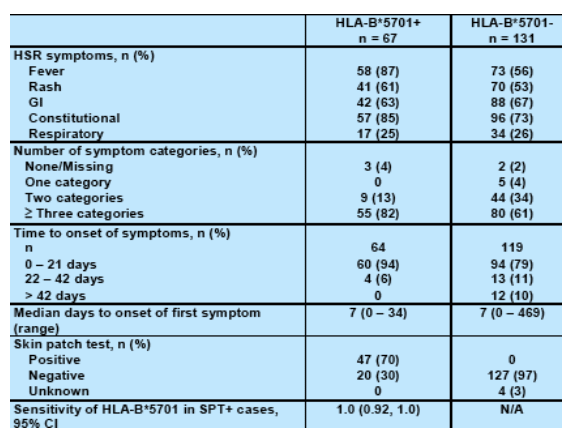
CONCLUSIONS: Subjects who carry the HLA-B*5701 allele are more likely than those without the allele to present with fever, and to have three or more categories of ABC HSR symptoms. All HLA-B*5701+ subjects had onset of ABC HSR within 34 days of starting ABC use. HLA-B*5701 is a highly sensitive marker for SPT+ ABC HSR; subjects who are HLA-B*5701- are unlikely to have a positive skin patch test result.
INTRODUCTION
--Presence of the HLA-B*5701 allele is strongly associated with the development of hypersensitivity reaction to abacavir.1, 2
--Symptom categories typically associated with ABC HSR (fever, rash, GI, constitutional, respiratory) can be non-specific and can decrease diagnostic precision.
--SHAPE was a retrospective case-control study which demonstrated high sensitivity of HLA-B*5701 for immunologically-confirmed (skin patch test (SPT)
positive) ABC HSR in both Black and White subjects.
--This analysis evaluated the clinical presentation of ABC HSR based on HLA-B*5701 status.
METHODS
ABC HSR cases in SHAPE were identified from clinical practice and must have met specific entry criteria to be included:
--Clinical symptoms in at least 2 categories (fever, rash, GI, constitutional)
--Onset of symptoms within 6 weeks of initiating ABC and resolution of one or more symptoms upon discontinuation of ABC.
All subjects with clinically-suspected ABC HSR underwent ABC skin patch testing and HLA-B*5701 evaluation (see Figure 1).
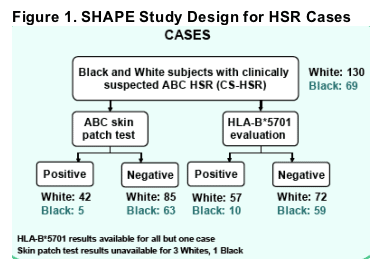
Primary study results have been previously presented.3
Descriptive results were summarized by HLA-B*5701 status. Because descriptive results were comparable across race, they have been combined for this analysis.
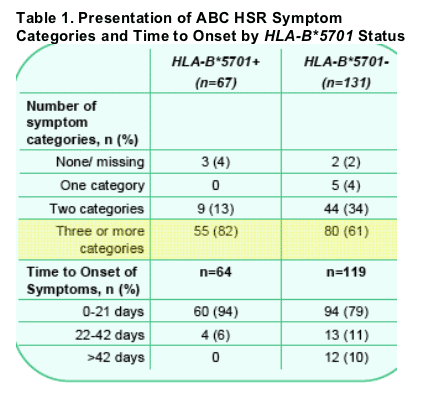
The median time to onset was the same for both the HLA-B*5701 positive and negative groups (7 days) with ranges of 0-34 days and 0-469 days, respectively.
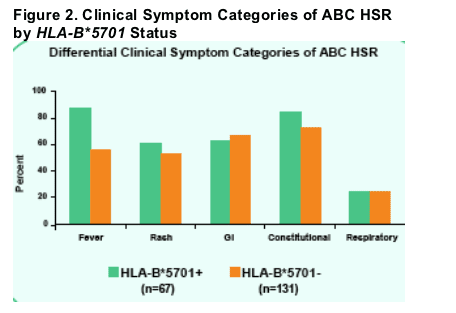
Subjects who were HLA-B*5701 positive reported fever (87% vs 56%) and constitutional (85% vs 73%) symptom categories more often than HLA-B*5701 negative subjects as part of ABC HSR clinical presentation (Figure 2). The
most common symptoms are presented in Table 2 by time to onset.
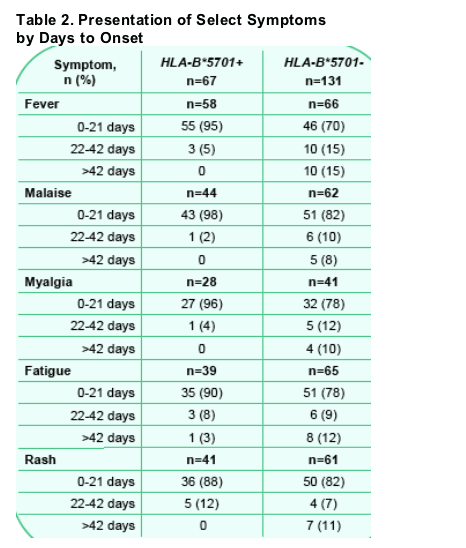
As noted above, fever, malaise, myalgia and fatigue were more commonly reported in subjects who were positive for HLA-B*5701 than in those who were not. Rash, however, was reported nearly as often in both groups.
References
1. Mallal, et al. Lancet, 2002.
2. Hetherington, et al Lancet, 2002.
3. Saag M, et al. 4th IAS 2007:Oral WEAB305.
|
| |
|
 |
 |
|
|